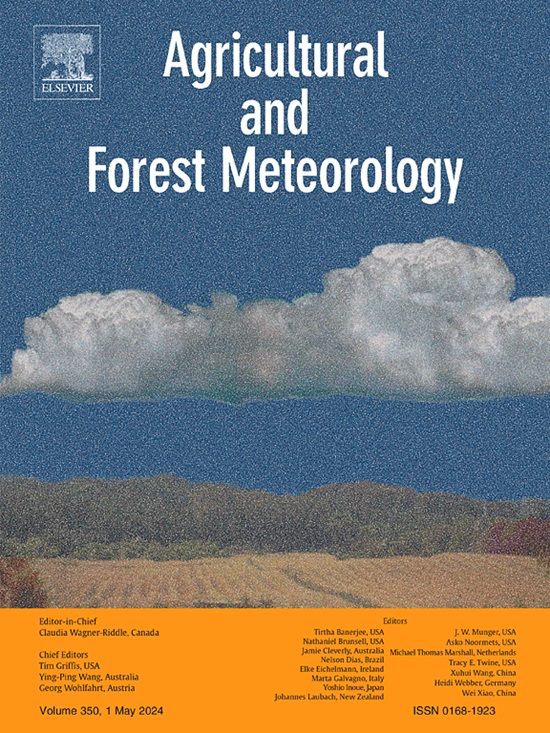Cosmic-ray neutron sensors provide scale-appropriate soil water content and vegetation observations for eddy covariance stations in agricultural ecosystems
IF 5.7
1区 农林科学
Q1 AGRONOMY
引用次数: 0
Abstract
Continuous information on soil water content (SWC) and plant development is crucial for environmental monitoring, agricultural management, and beyond. Cosmic-ray neutron sensors (CRNS), widely used to estimate SWC, also have the potential to monitor field-scale variations in vegetation properties. In this study, a CRNS measured both epithermal () and thermal () neutron intensities over a 10-year period at an ICOS Class 1 ecosystem station in Selhausen (Germany). Compared to nearby point-scale sensors, the CRNS provided more representative SWC estimates within the monitoring area of the adjacent eddy covariance (EC) station. A general co-development was observed between and gross primary productivity (GPP), but differences during senescence and desiccation suggest that factors beyond plant water content can influence . An extensive dataset of plant height (PH), leaf area index (LAI), and dry above-ground biomass (AGB) was used to evaluate the ability of to monitor plant development. was found to be more closely related to vegetation dynamics than to changes in SWC. CRNS estimations of PH, LAI, and AGB yielded relatively good agreement with reference data (RMSE of 0.13 m, 1.01 m2/m2, and 0.27 kg/m2, respectively). The RMSE obtained with a leave-one-out cross validation generally confirmed these findings. Although CRNS estimates generally had lower accuracy than traditional methods, they have the key advantages of being continuous, non-invasive, and non-laborious. Combined with simultaneous estimation of SWC at a relevant spatial scale, CRNS becomes a particularly interesting tool among long-term monitoring platforms with further potential in modelling, remote sensing, and decision-making in agriculture.
宇宙射线中子传感器为农业生态系统涡动相关站提供了尺度适宜的土壤含水量和植被观测
土壤含水量(SWC)和植物发育的持续信息对环境监测、农业管理等至关重要。宇宙射线中子传感器(CRNS)广泛用于估算SWC,也具有监测植被特性野外尺度变化的潜力。在这项研究中,CRNS在德国塞尔豪森(Selhausen)的ICOS 1类生态系统站测量了10年的低温(EN)和热(TN)中子强度。与附近的点尺度传感器相比,CRNS在邻近涡动相关(EC)站的监测区域内提供了更具代表性的SWC估计。全氮与总初级生产力(GPP)总体上是共同发展的,但在衰老和干燥过程中的差异表明,植物含水量以外的因素也会影响全氮。利用植物高度(PH)、叶面积指数(LAI)和地上干生物量(AGB)的广泛数据来评估全氮监测植物发育的能力。TN与植被动态的关系比与SWC变化的关系更密切。CRNS估计的PH、LAI和AGB与参考数据的一致性相对较好(RMSE分别为0.13 m、1.01 m2/m2和0.27 kg/m2)。用留一交叉验证获得的均方根误差一般证实了这些发现。尽管CRNS估计的准确性通常低于传统方法,但它们具有连续、非侵入性和不费力的关键优势。结合相关空间尺度上SWC的同步估算,CRNS成为长期监测平台中特别有趣的工具,在农业建模、遥感和决策方面具有进一步的潜力。
本文章由计算机程序翻译,如有差异,请以英文原文为准。
求助全文
约1分钟内获得全文
求助全文
来源期刊
CiteScore
10.30
自引率
9.70%
发文量
415
审稿时长
69 days
期刊介绍:
Agricultural and Forest Meteorology is an international journal for the publication of original articles and reviews on the inter-relationship between meteorology, agriculture, forestry, and natural ecosystems. Emphasis is on basic and applied scientific research relevant to practical problems in the field of plant and soil sciences, ecology and biogeochemistry as affected by weather as well as climate variability and change. Theoretical models should be tested against experimental data. Articles must appeal to an international audience. Special issues devoted to single topics are also published.
Typical topics include canopy micrometeorology (e.g. canopy radiation transfer, turbulence near the ground, evapotranspiration, energy balance, fluxes of trace gases), micrometeorological instrumentation (e.g., sensors for trace gases, flux measurement instruments, radiation measurement techniques), aerobiology (e.g. the dispersion of pollen, spores, insects and pesticides), biometeorology (e.g. the effect of weather and climate on plant distribution, crop yield, water-use efficiency, and plant phenology), forest-fire/weather interactions, and feedbacks from vegetation to weather and the climate system.

 求助内容:
求助内容: 应助结果提醒方式:
应助结果提醒方式:


